
May 13, 2022 Updated October 22, 2023
544
1 votes
Reading time: 14 minutes
You can find many patterns on a price chart that indicate where prices may go in the near future. One of the important ones is the Inverted Hammer Pattern. This guide will show you how to recognize this pattern and use it to make your trading decisions. Familiarize yourself with the Inverted Hammer because it is a vital pattern for technical traders–those who trade based on chart patterns.
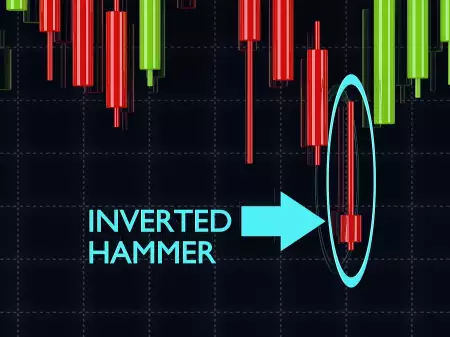
This candlestick pattern signals a possible reversal of a price trend. In particular, the Inverted Hammer at the bottom of a downtrend suggests that prices may turn upward, or bullish. It is a very clear pattern with a highly recognizable shape.
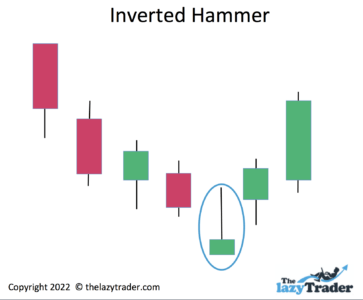
In the example, notice that prices dropped, an inverted hammer formed, then prices went back up from there.
The Inverted Hammer is one of several patterns technical traders use. Technical trading is based on common formations in price charts that have repeatedly been good indicators of future price direction. This is opposed to fundamental trading, where investors research a company’s financial condition and prospects.
This approach analyzes a company based on sales, profits, debt, market share, and the quality of management. Then investors look at the price to earnings ratio (P/E) and other factors to determine the asset’s fair value. The goal of many fundamental investors is to buy when the price is below fair value. This is not a science. Fair value is an opinion, and different analysts will determine a different fair value.
The most notable fundamental investors is Warren Buffet. He examines company fundamentals and looks for “value stocks”-those below fair value.
Technical traders are less likely to look at company finances, choosing to go with price momentum or reversals instead. They identify probable price directions based on commonly accepted patterns. One form of technical analysis uses candlesticks, which are graphic representations of price action. Familiar candlesticks have indicated price direction in the past, so technical traders use them to make investment decisions.
They watch charts, identify trends, look for price support and resistance levels, and monitor the volume (the number of shares being traded) to find investment opportunities. The most famous technical trader was Munehisa Homma, an 18th-century Japanese rice trader who became wealthy by inventing and using candlesticks to find price trends. His candlesticks are in use today. The idea is to trade what you see, not what you think should happen.
No analysis–technical or fundamental–is right 100% of the time. As we look at the Inverted Hammer, consider it an indicator of possible direction, not a sign of a sure thing.
The Inverted Hammer offers technical traders some advantages over fundamental traders, but it also is not perfect, so you need to watch out for some pitfalls.
Makes trading more objective – You are less likely to make emotional decisions because the Inverted Hammer is clear and easy to see. A fundamental approach does not offer any trading signal and can make you prone to fearful investing.
A proven technique – The Inverted Hammer has been used for a long time and has become a go-to signal for technical traders.
Accessible and easy to understand – Most charts offer candlestick views, and you can easily identify an Inverted Hammer on such a chart. They make intuitive sense–you can tell yourself a story about seeing sellers get exhausted as they are unable to drive prices lower.
Helps to provide clarity – When you can see a pattern, it is easier to understand what it means. You do not have to rely on economic and financial analysis because the reversal of prices is graphically represented.
Reflects the psychology of the market – Though candlesticks look like simple drawings, they are, in fact, a representation of the psychology of buyers and sellers. You can see a consensus developing. The Inverted Hammer shows that sellers are losing their enthusiasm.
Weakness as an indicator – An Inverted Hammer is a one-day indicator. That means it is not as reliable as multi-day patterns or trends.
Tends to be visible only in a short timeframe – You have to watch charts daily to see an Inverted Hammer. They pass by quickly. If you are watching a downtrend and are waiting for a reversal, constant vigilance is necessary.
Viable trade setups can be invalidated by unpredictable news or data releases – Many traders trade the news. A sudden news announcement or company report can interrupt the pattern as buyers and sellers react.
Charles Dow is credited with making technical trading widespread, and this included the Inverted Hammer pattern. He helped create of Dow Jones, and the Dow Jones Industrial Average is sited daily as an index for the market.
Today, Jack Schwager is considered a prominent user of technical analysis. HIs book Market Wizards provides guidance on using the Inverted Hammer.
Sudarshan Sukhani is also famous for expertise in technical trading, including the Inverted Hammer pattern. He is the president of the Association of Technical Analysts.
An Inverted Hammer always has a small body and a long upper shadow, but it can be either green or red. Green means the price closed up, and red means the price closed down. Both red and green are bullish reversal patterns.
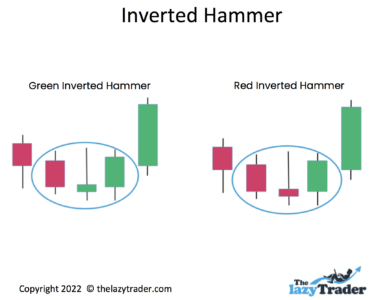
The first thing you must do is identify a downtrend.
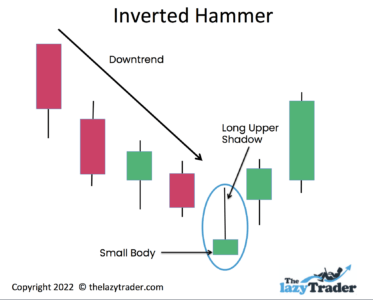
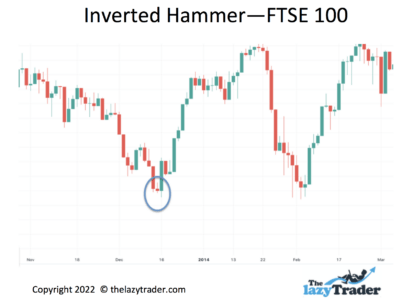
You have several ways you can trade the Inverted Hammer. Your choice of methods will depend on your risk tolerance and time frame. That is, if you are trading for short-term profits and are willing to take on increased risk, you will choose the method that gets you into the trade quickly. Others may want to be more cautious and allow a period of three days or more before making a trade.
In the first example, you see a clear hammer formation after an extended downtrend. Wait until trading closes to make sure the Hammer is completely formed. Then enter the trade the next day.
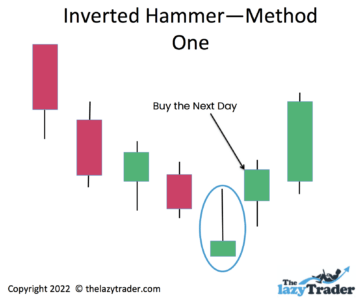
The second method is about waiting. Watch for two or three up days to confirm the new direction.

Officially, when you wait for confirmation days, the pattern is called the Morning Star.
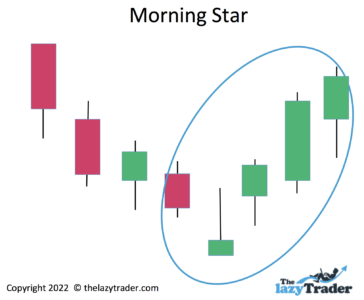
You have three exit strategies. You can place a stop-loss order at a specific price. Choose a price that represents the most you are willing to lose. Your stop-loss order will trigger a sale if the price drops that low. You may choose a percentage loss instead of naming the actual price.
You may say, “I don’t want to lose any money. Why not just set my stop-loss order at the price I bought the stock?” Doing this may get you “stopped out.” That means that during the normal fluctuations, the price may temporarily drop back to where you bought it and trigger a sale before it bounces back up. Choose a percentage of 5-10% or, if you are willing to take on higher risk more, select 15%. It is very easy to get stopped out if you set the trigger at 1-2%.
A variation on the stop-loss is the trailing stop-loss. You set this at a percentage. IF the stock goes up in price, the trailing stop-loss moves up with it, so you always have the same percentage loss you will tolerate. That means you would lock in a profit.
Tip: A trailing stop-loss order never moves downward when prices drop.
Your third choice is to hold the stock until you see a reversal pattern after the stock trends up for a while. That reversal pattern will suggest prices may drop.
You do not have to worry yourself after entering a trade, but you should watch it. Be prepared to change your strategy or even close the trade early. Don’t make such a decision based on panic or fear; just learn about technical trading and be aware of bearish signals that indicate prices may drop.
Tip: Some traders sell part of their position as profit goes up. That means you will guarantee you have profit and reduce the risk if the price action turns against you.
The Inverted Hammer pattern is one of many tools technical traders use. You can learn more about it through sources that deal with technical trading. Learn how patterns work, including the Inverted Hammer, so you will understand the context for using that pattern.
You will need to learn about candlestick trading. This is a graphic representation of prices, as seen throughout the images in this guide.
Here are some learning sources to get you started.
Trade What You See How to Profit from Pattern Recognition by Larry Pesavento
This is a book to help you recognize patterns in charts. It is especially useful for learning to find patterns while they are developing instead of merely identifying them after they have developed.
Trading In The Zone by Mark Douglas)
This book on general trading principles covers things like eliminating bad habits and remaining consistent in your strategy. It shows how to trade probabilities and ignore anomalies.
You will find some excellent trading courses online, but remain aware that some “courses” are come-ons that give you a little free information but charge you extra for the in-depth stuff.
Here are some reliable ones.
Udemy Technical Trading
Udemy offers a comprehensive guide to all aspects of technical trading and is a reliable source for valid information. Though they promote their own courses as part of this course, you won’t get come-ons to draw you into long-term commitments.
Travis Rose
This is a good place for beginners to start. Rose covers all the basics and leads you through analyzing technical patterns.
Bullish Bears
A learn-as-you-go approach works well at Bullish Bears. You build your skills systematically while actually trading. You can elect to make practice trades with no actual money invested.
Blogs can be good if they are offered by a pro with a track record. Look for blogs that walk you through various technical setups in the actual market. Keep score and see how often the blogger is right. Anyone can start a blog, so look for those associated with a recognized expert.
Here are some to look at:
Adam H. Grimes
Grimes has more than 20 years of experience and covers all types of trades, from breakouts to reversals of trends. His posts walk you through trades and keep you abreast of trends in the current marketplace.
Top-Down Charts
The emphasis here is on the macro trends. Great for learning how large trends affect individual charts. While you do want nuts-and-bolts training on how to trade, this focus on trends and the economy is essential to giving context to your trading strategies.
Marc to Market
This daily blog focuses on Forex. Note that many of the technical trading principles of Forex apply to trading stocks as well.
Be aware that forums allow anyone to express an opinion. Take all advice in stride, as you don’t always know the credentials of the poster.
Some popular ones:
Elite Trader
Elite Trader offers forums on every type of trading style and approach. It is a good idea to join discussions that may be outside of your current interests so you can learn about various methods. Look at the general technical forums first, and then launch into technical forums on stocks, Forex, commodities, etc.
Morningstar
Morningstar forums have some quality input from experienced technical traders. You won’t find any wild observations or insights here, but keep in mind that not everything in a forum is reliable.
Look for newsletters from seasoned pros. A good newsletter will give you tips and specific recommendations.
The Technical Indicator–Marketwatch
Here you will find in-depth chart analysis. This is the most helpful way to learn because each newsletter uses current technical setups. You can see actual patterns developing in the marketplace, including the Inverted Hammer.
Trade-Ideas Strength Alerts
The focus is on the Relative Strength Index. This index alone can show you reversal points and entry points. The strength alerts in this newsletter are invaluable for anyone wanting to use technical analysis. This is good for learning how the Relative Strength Index can work with the Inverted Hammer.
Morningstar Investor Newsletters
There are a variety of newsletters here to choose from. Select those areas of technical analysis you want to learn, and follow them regularly to get a knack for spotting trends and trading patterns.
Podcasts are like newsletters, but choose an expert, not just someone selling something.
Allstarcharts Podcast on Technical Analysis Radio
This podcast offers timely insights into technical setups, trends, and reversals happening in the current marketplace. Use it to see how and when an Inverted Hammer forms.
The Weekly Trend
This podcast looks across all markets and provides technical analysis of the price action.
YouTube is the home of many a fake guru, so beware. However, you can glean important information on YouTube. Just make sure you verify it and don’t fall for videos that make claims such as “investing tricks Wall Street doesn’t want you to know,” or “my secret trading method that made me millions.”
Examine these to get started:
The Only Technical Analysis Video You Will Ever Need
While the claim made in the title is a bit over-the-top, this 45-minute video does take you through many technical analysis examples in detail.
Candlesticks-Vol. 8-Inverted Hammer
This is presented by YourTradingCoach.com and is available free on YouTube.
It focuses exclusively on the Inverted Hammer and offers insights into how to trade it.
Inverted Hammer Signal by Stephen Bigalow
This offers an in-depth look at how and why this pattern works.
Webinars can be thinly disguised sales pitches. Make sure you learn nuts-and-bolts information.
Online Trading Academy
This gives a solid approach to technical trading, with examples. It includes the Inverted Hammer.
Technical Analysis–Fidelity
Fidelity is a reliable name, and the variety of technical trading webinars here adds a comprehensive and trustworthy series that can help you profit. It covers the Inverted Hammer.
You don’t have to use the Inverted Hammer, but you should make an informed decision.
The first consideration is that it is a one-day pattern. If you don’t like watching charts daily, you may want patterns that take several days or weeks to form.
Secondly, identifying a bottom in prices is tricky even for experts. Make some paper trades (with no money) to see how well you can spot this pattern.
You have to be comfortable taking some risks. Do not put huge amounts into an Inverted Hammer trade when you are starting out. Practice. A lot.
Also, learn to watch downtrends. These can be opportunities if you wait until you see an Inverted Hammer.
The Inverted Hammer is not a “secret trick” the experts don’t know. It has been used for a long time, as in centuries. Don’t expect to make a killing by becoming adept at using the Inverted Hammer. Go slow, expect to get it wrong sometimes, learn, and learn some more.
Even after you gain some experience, don’t treat Inverted Hammer like a sure thing. Study your winning trades and examine the losers. Remember, even when an Inverted Hammer looks perfect, the market can turn on you and drive prices down.
Never put more than 1-2% of your money into an Inverted Hammer trade. You’re not trying to make a killing; you just hope to make a profit. Putting too much in a reversal trade can deplete your funds.
Establish rules for entry and exit on trades and stick to those rules. You have some suggestions and guidelines in this guide, so make choices that make sense to you and don’t change every time you make a mistake.
This platform allows traders to communicate as you do on Twitter and Facebook. You can share trading ideas and experiences with other traders. One useful feature is the ability to examine professionally managed portfolios.
Ava offers platforms for multiple experience levels. You can automate your trades and follow expert traders to learn from their insights.
This platform is not available in the U.S. Naga allows you to copy the best traders on the platform. You can trade stocks, cryptocurrencies, and forex across the world.
FP uses the Autotrade tool. This allows traders to copy-trade, and it offers live statistics, along with risk-management systems. You can see the entire trading history of the most successful traders and mimic their methods.
The platform allows a low minimum deposit. Those trading for the first time can get started here. Free demo available. Trade Forex, commodities, indices, stock, and cryptocurrencies.
Several tools will help you analyze the markets and individual assets. You can use the criteria you choose to search for possible trades. You will find candlesticks on these platforms and you can watch for the Inverted Hammer.
This is professional-level software. It allows you to test your ideas and set technical criteria for searching the market. Some additional features cost extra, so make sure you understand what you get with the various versions.
This platform has more than 100 indicators you can use to evaluate potential trades. You can create alerts and watchlists and even get market news. However, it may be a bit advanced for those starting out.
MetaStock has more than 150 tools and offers an evaluation of what those tools indicate for a potential trade. This is for those who want to do a deep dive into all the possible indicators – including some you can create yourself.
Highly customizable charts and indicators make this attractive to those who are growing their knowledge.
This highly intuitive platform is a place to learn all your technical tools. It doesn’t do the analysis for you, but it allows you to play with different indicators to see which you like best.
It is easy to focus on your winners and forget about your losers. Don’t rely on your memory to evaluate how you are doing with your trades. We all tend to have a favorable view of our performance. Keep a record of your trades and periodically evaluate them. Count your winners vs. losers and note if you are making money.
Gapping – This is a sudden surge in a price with no gradual rise. Instead, the asset will open higher with no intervening trades. IF this happens in the days following an Inverted Hammer, consider it confirmation of the new trend.
Volume – This is the number of shares exchanged each day. If you see an increase in volume on up-trades after an Inverted Hammer, that suggests strength.
Stop-loss – Set a stop-loss order that executes automatically if the price drops to a specified level.
Dead cat bounce – It refers to a fake price recovery after an asset has dropped severely in price. The bounce does not sustain itself, and prices continue to drop.
Moving average – This is the average price direction over a specified period. Use a moving average to identify a downward trend.
Trend line – This is an imaginary line you can draw across the highs and lows (peaks and valleys) of prices. Draw the line access the lows for an upward trend and across the highs for a downward trend.
Stop-Loss Order – You place a sell order that automatically triggers if prices drop to a specific point. You choose this based on your tolerance for losses.
Limit Order – This is a buy order that specifies the price at which you want the trade to execute. In other words, it is the most you are willing to pay.
Getting Stopped Out – This happens when you set a stop-sell order too close to the current price. Normal fluctuations can cause the price to drop momentarily, triggering a sell when you don’t want one.
Shadow – This is the “wick” on the candle in a candlestick pattern. A longer wick means prices rose or fell more.
To do technical trading properly, don’t rely only on the Inverted Hammer. There are many more patterns you should know. That said, the Inverted Hammer is one of the most significant one-day patterns. Study it and learn it, and you will become adept at identifying trend reversals after downtrends.
It is considered one of the most reliable candlestick patterns. Remember that “most reliable” does not mean 100%.
This pattern shows you that sellers may be giving out. When buyers take over, prices will rise.
A Hammer at the top of an uptrend indicates prices may drop. An Inverted Hammer at the bottom of a downtrend indicates prices may rise.
The Inverted Hammer is bullish.
A: Watch for “capitulation.” An Inverted Hammer happens during a downtrend. However, if prices drop below the level of the Inverted Hammer, buyers may give up, or capitulate. Once they pull out, there could be a significant downside risk.

